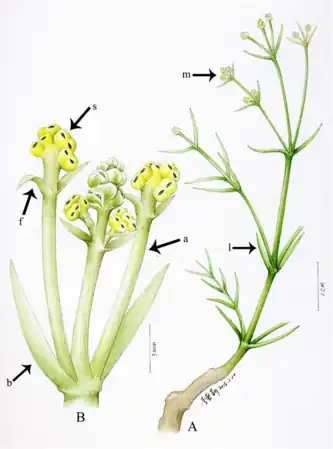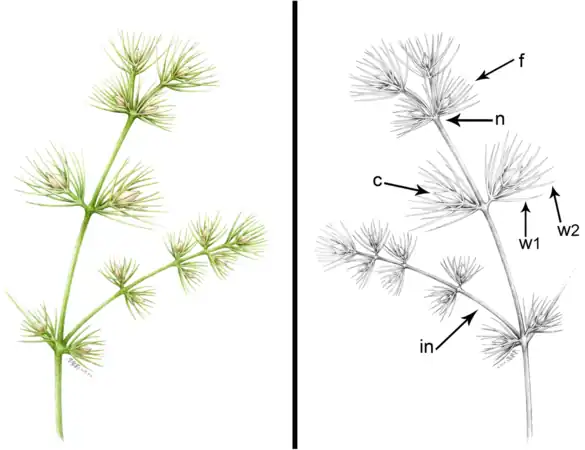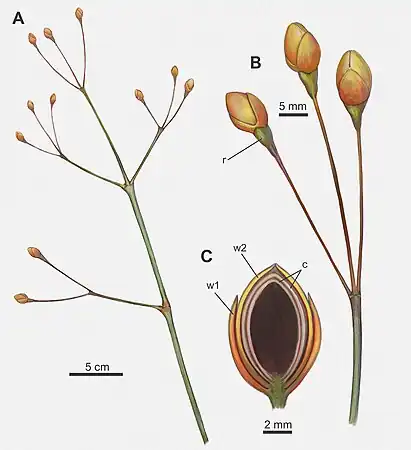Ephedraceae
Ephedraceae is a family of gymnosperms belonging to Gnetophyta, it contains only a single extant genus, Ephedra, as well as a number of extinct genera from the Early Cretaceous.
| Ephedraceae Temporal range: | |
|---|---|
 | |
| Ephedra nevadensis | |
 | |
| Restoration of Arlenea from the Early Cretaceous of Brazil | |
| Scientific classification | |
| Kingdom: | Plantae |
| Clade: | Tracheophytes |
| Clade: | Gymnosperms |
| Division: | Gnetophyta |
| Class: | Gnetopsida |
| Order: | Ephedrales Dumort.[1] |
| Family: | Ephedraceae Dumort.[2] |
| Genera | |
|
See text | |
Taxonomy
- Fossil Ephedraceae
 Eamesia, showing male cone (B)
Eamesia, showing male cone (B) Chengia, showing female reproductive spike (B)
Chengia, showing female reproductive spike (B) Jianchangia, showing chlamydosperms (C) and ovulate cone (F)
Jianchangia, showing chlamydosperms (C) and ovulate cone (F) Diagram of Arlenea, showing closeup of terminal region with female reproductive structures (B) and cross section of a female reproductive structure.(C)
Diagram of Arlenea, showing closeup of terminal region with female reproductive structures (B) and cross section of a female reproductive structure.(C)
Ephedraceae is agreed to be the most basal group amongst extant gnetophytes. Members of the family typically grow as shrubs and have small, linear leaves that possess parallel veins. The fossil Ephedraceae genera show a range of morphologies transitional between the ancestral lax male and female reproductive structures and the highly compact reproductive structures typical of modern Ephedra.[3][4] Modern members of Ephedra have either dry winged membranous bracts (modified leaves which surround the seed), which are dispersed by wind, leathery covered seeds, which are dispersed by seed-eating rodents, or fleshy bracts which are consumed and then dispersed by birds. Some extinct members of Ephedra from the Early Cretaceous, such as Ephedra carnosa, as well as Arlenea from the Early Cretaceous of Brazil have fleshy bracts surrounding the seeds, suggesting that these seeds were dispersed by animals.[5]
Genera
- Ephedra L. Early Cretaceous-Recent
- Arlenea Ribeiro, Yang, Saraiva, Bantim, Calixto Junior et Lima, 2023[5] Crato Formation, Brazil, Early Cretaceous (Aptian)
- Leongathia V.A. Krassilov, D.L. Dilcher & J.G. Douglas 1998[6] Koonwarra fossil bed, Australia, Early Cretaceous (Aptian)
- Jianchangia Yang, Wang and Ferguson, 2020[7] Jiufotang Formation, China, Early Cretaceous (Aptian)
- Eamesia Yang, Lin and Ferguson, 2018[3] Yixian Formation, China, Early Cretaceous (Aptian)
- Prognetella Krassilov et Bugdaeva, 1999 Yixian Formation, China, Early Cretaceous (Aptian) (initially interpreted as an angiosperm)[8]
- Chengia Yang, Lin & Wang, 2013,[9] Yixian Formation, China, Early Cretaceous (Aptian)
- Chaoyangia Duan, 1998[10] Yixian Formation, China, Early Cretaceous (Aptian)
- Eragrosites Cao & Wu, 1998 Yixian Formation, China, Early Cretaceous (Aptian)
- Gurvanella Krassilov, 1982 China, Mongolia, Early Cretaceous
- Alloephedra Tao and Yang, 2003 China, Early Cretaceous (considered a synonym of Ephedra by some authors)
- Amphiephedra Miki, 1964 China, Early Cretaceous
- Beipiaoa Dilcher & al, 2001 China, Early Cretaceous
- Ephedrispermum Rydin, K.R.Pedersen, P.R.Crane et E.M.Friis, 2006 Portugal, Early Cretaceous (Aptian-Albian)
- Ephedrites Guo and Wu, 2000 China, Early Cretaceous
- Erenia Krassilov, 1982 China, Mongolia, Early Cretaceous
- Liaoxia[11] Cao et al. 1998 China, Early Cretaceous
- Dichoephedra Ren et al. 2020[12] China, Early Cretaceous
- ?Pseudoephedra Liu and Wang, 2015[13] China, Early Cretaceous
References
- "Ephedrales Dumort". EU-NOMEN. Retrieved 20 January 2016.
- Kramer KU, Green PS, Götz E (1990). Kramer KU, Green PS (eds.). The Families and Genera of Vascular Plants, Vol. 1: Pteridophytes and Gymnosperms. Berlin: Springer-Verlag. pp. 379–381. ISBN 3540517944.
- Yang, Yong; Lin, Longbiao; Ferguson, David K.; Wang, Yingwei (December 2018). "Macrofossil evidence unveiling evolution of male cones in Ephedraceae (Gnetidae)". BMC Evolutionary Biology. 18 (1): 125. doi:10.1186/s12862-018-1243-9. ISSN 1471-2148. PMC 6116489. PMID 30157769.
- Yang, Yong (2014-02-04). "A systematic classification of Ephedraceae: living and fossil". Phytotaxa. 158 (3): 283. doi:10.11646/phytotaxa.158.3.8. ISSN 1179-3163.
- Ribeiro, Alita Maria Neves; Yang, Yong; Saraiva, Antônio Álamo Feitosa; Bantim, Renan Alfredo Machado; Calixto Junior, João Tavares; de Lima, Flaviana Jorge (June 2023). "Arlenea delicata gen. et sp. nov., a new ephedroid plant from the Early Cretaceous Crato Formation, Araripe Basin, Northeast Brazil". Plant Diversity. doi:10.1016/j.pld.2023.06.008.
- Krassilov, V.A.; Dilcher, D.L.; Douglas, J.G. (January 1998). "New ephedroid plant from the Lower Cretaceous Koonwarra Fossil Bed, Victoria, Australia". Alcheringa: An Australasian Journal of Palaeontology. 22 (2): 123–133. doi:10.1080/03115519808619195. ISSN 0311-5518.
- Yang, Yong; Wang, Yingwei; Ferguson, David Kay (2020-02-04). "A new macrofossil ephedroid plant with unusual bract morphology from the Lower Cretaceous Jiufotang Formation of northeastern China". BMC Evolutionary Biology. 20 (1): 19. doi:10.1186/s12862-019-1569-y. ISSN 1471-2148. PMC 7001366. PMID 32019502.
- Yang, Yong; Ferguson, David K. (October 2015). "Macrofossil evidence unveiling evolution and ecology of early Ephedraceae". Perspectives in Plant Ecology, Evolution and Systematics. 17 (5): 331–346. doi:10.1016/j.ppees.2015.06.006.
- Yang, Yong; Lin, Longbiao; Wang, Qi (2013-03-27). "Chengia laxispicatagen. et sp. nov., a new ephedroid plant from the Early Cretaceous Yixian Formation of western Liaoning, Northeast China: evolutionary, taxonomic, and biogeographic implications". BMC Evolutionary Biology. 13 (1): 72. doi:10.1186/1471-2148-13-72. ISSN 1471-2148. PMC 3626868. PMID 23530702.
- Duan, Shuying (April 1998). "The oldest angiosperm—a tricarpous female reproductive fossil from western Liaoning Province, NE China". Science in China Series D: Earth Sciences. 41 (1): 14–20. doi:10.1007/BF02932415. ISSN 1006-9313. S2CID 195305514.
- Rydin, C.; Wu, S. Q.; Friis, E. M. (December 2006). "Liaoxia Cao et S.Q. Wu (Gnetales): ephedroids from the Early Cretaceous Yixian Formation in Liaoning, northeastern China". Plant Systematics and Evolution. 262 (3–4): 239–265. doi:10.1007/s00606-006-0481-2. ISSN 0378-2697. S2CID 43425154.
- Ren, Wen-Xiu; Tang, De-Liang; Wang, Zhuo-Er; Sun, Bai-Nian; Wu, Jing-Yu; Ding, Su-Ting (October 2022). "Dichoephedra beishanensis gen. et sp. nov., a new ephedroid plant with unusual branching patterns from the Lower Cretaceous of northwestern China". Cretaceous Research. 138: 105284. doi:10.1016/j.cretres.2022.105284. S2CID 249654802.
- Liu, Zhong-Jian; Wang, Xin (January 2016). "An enigmatic Ephedra -like fossil lacking micropylar tube from the Lower Cretaceous Yixian Formation of Liaoning, China". Palaeoworld. 25 (1): 67–75. doi:10.1016/j.palwor.2015.07.005.